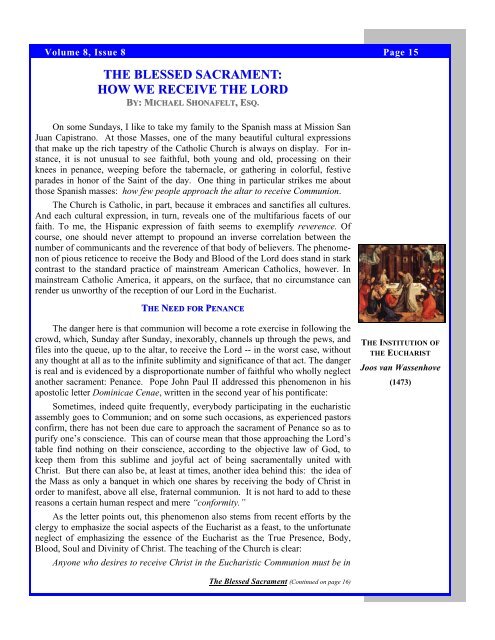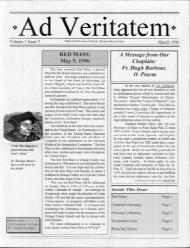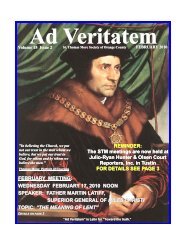You also want an ePaper? Increase the reach of your titles
YUMPU automatically turns print PDFs into web optimized ePapers that Google loves.
Volume 8, Issue 8Page 15THE BLESSED SACRAMENT:HOW WE RECEIVE THE LORDBY: : M: MICHAELSHONAFELT, , ESQ.On some Sundays, I like to take my family to the Spanish mass at Mission SanJuan Capistrano. At those Masses, one of the many beautiful cultural expressionsthat make up the rich tapestry of the Catholic Church is always on display. For instance,it is not unusual to see faithful, both young and old, processing on theirknees in penance, weeping before the tabernacle, or gathering in colorful, festiveparades in honor of the Saint of the day. One thing in particular strikes me aboutthose Spanish masses: how few people approach the altar to receive Communion.The Church is Catholic, in part, because it embraces and sanctifies all cultures.And each cultural expression, in turn, reveals one of the multifarious facets of ourfaith. To me, the Hispanic expression of faith seems to exemplify reverence. Ofcourse, one should never attempt to propound an inverse correlation between thenumber of communicants and the reverence of that body of believers. The phenomenonof pious reticence to receive the Body and Blood of the Lord does stand in starkcontrast to the standard practice of mainstream American Catholics, however. Inmainstream Catholic America, it appears, on the surface, that no circumstance canrender us unworthy of the reception of our Lord in the Eucharist., ETHENEEDFOR PENANCEThe danger here is that communion will become a rote exercise in following thecrowd, which, Sunday after Sunday, inexorably, channels up through the pews, andfiles into the queue, up to the altar, to receive the Lord -- in the worst case, withoutany thought at all as to the infinite sublimity and significance of that act. The dangeris real and is evidenced by a disproportionate number of faithful who wholly neglectanother sacrament: Penance. Pope John Paul II addressed this phenomenon in hisapostolic letter Dominicae Cenae, written in the second year of his pontificate:Sometimes, indeed quite frequently, everybody participating in the eucharisticassembly goes to Communion; and on some such occasions, as experienced pastorsconfirm, there has not been due care to approach the sacrament of Penance so as topurify one’s conscience. This can of course mean that those approaching the Lord’stable find nothing on their conscience, according to the objective law of God, tokeep them from this sublime and joyful act of being sacramentally united withChrist. But there can also be, at least at times, another idea behind this: the idea ofthe Mass as only a banquet in which one shares by receiving the body of Christ inorder to manifest, above all else, fraternal communion. It is not hard to add to thesereasons a certain human respect and mere “conformity.”As the letter points out, this phenomenon also stems from recent efforts by theclergy to emphasize the social aspects of the Eucharist as a feast, to the unfortunateneglect of emphasizing the essence of the Eucharist as the True Presence, Body,Blood, Soul and Divinity of Christ. The teaching of the Church is clear:Anyone who desires to receive Christ in the Eucharistic Communion must be inTHE INSTITUTION OFTHE EUCHARISTJoos van Wassenhove(1473)The Blessed Sacrament (Continued on page 16)













